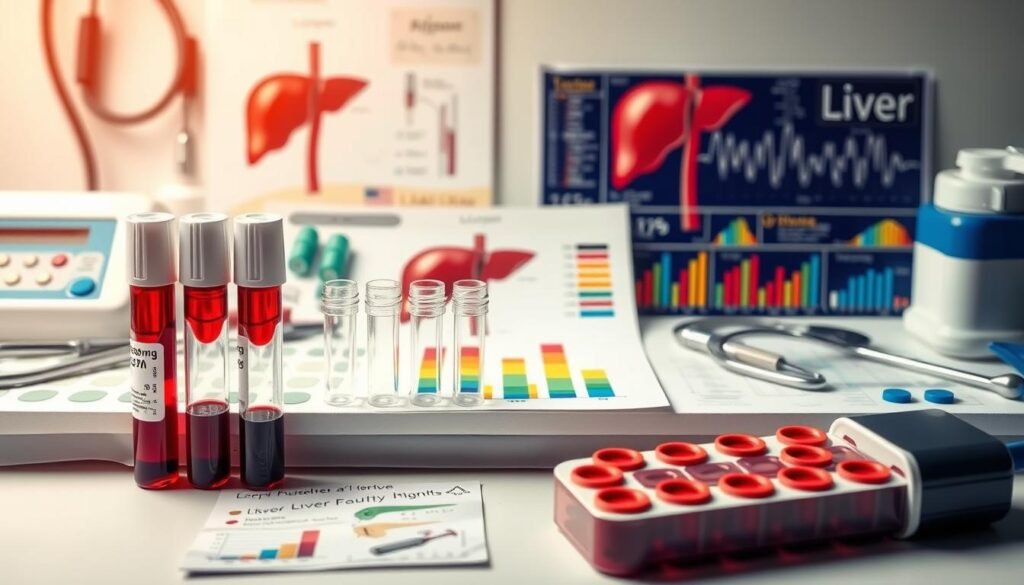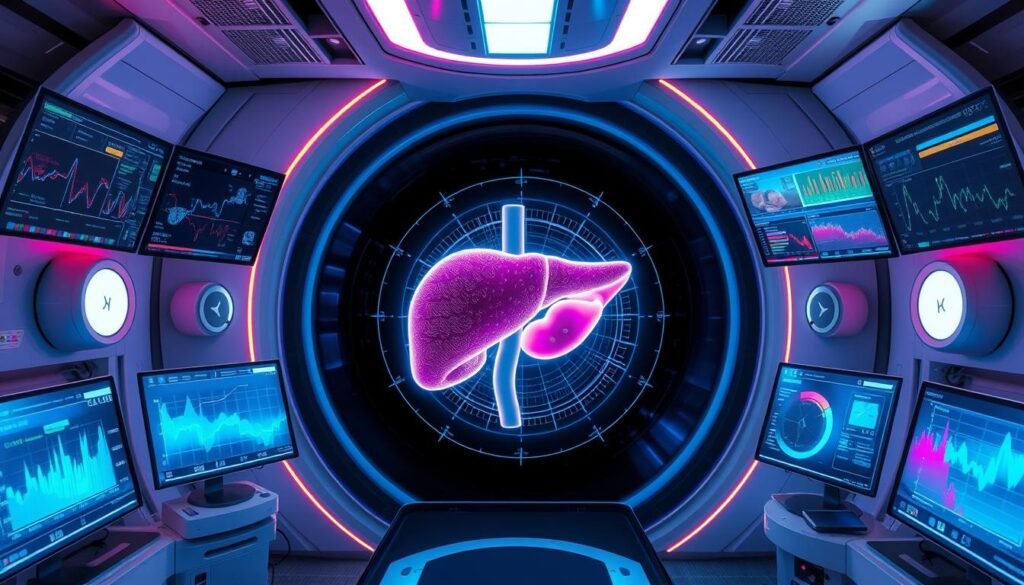About 25% of adults in the United States have fatty liver disease. This condition can lead to serious liver problems if not found and treated early. It’s key to catch it quickly using the right tests. This article will talk about how doctors test for fatty liver, helping you make good choices for your liver’s health.
There are many ways doctors can check for fatty liver disease. From blood tests to detailed body scans, we’ll look at all the options. Knowing these can help you act early for your liver’s wellbeing.
Key Takeaways
- Fatty liver disease affects approximately 25% of adults in the U.S.
- Early detection is vital for effective management of liver health.
- Diagnostic tools include liver function tests and various imaging techniques.
- Understanding liver enzyme levels is crucial in diagnosing fatty liver disease.
- Non-invasive tests provide a modern approach to liver health diagnosis.
- Liver biopsies are performed in specific cases when necessary.
Introduction to Fatty Liver Disease
Fatty liver disease, or hepatic steatosis, is now a common health issue in the United States. It mostly comes from not so good lifestyle habits like eating poorly, being overweight, and drinking too much alcohol. There are two main kinds: alcoholic fatty liver disease (AFLD) and non-alcoholic fatty liver disease (NAFLD).
AFLD comes from drinking too much alcohol. However, NAFLD is getting a lot of attention. It’s closely linked with metabolic syndrome, a health concern.
It’s crucial to understand how fatty liver disease is spreading and what risks it brings. Important risk factors include:
- Obesity
- Type 2 diabetes
- High cholesterol levels
- Poor dietary habits
- Sedentary lifestyle
By knowing how these factors work together, we can prevent liver problems. Education about food choices and staying active is key. Public health efforts are needed to fight the growing issue of fatty liver disease.
| Type of Fatty Liver Disease | Cause | Associated Risks |
|---|---|---|
| AFLD | Excessive alcohol consumption | Increased liver inflammation |
| NAFLD | Obesity, diabetes, poor diet | Metabolic syndrome, cardiovascular diseases |
The Importance of Early Detection
Finding fatty liver early is key to keeping the liver healthy and avoiding big problems. Doctors can catch liver issues early, so you can change how you live and get the right medical help. This can greatly lessen the chance of getting very sick from liver diseases.
Getting your liver checked regularly is very important. Check-ups can spot early signs of fatty liver disease. Especially if you are overweight, have diabetes, or liver diseases run in your family, you should get checked. This helps find any liver issues sooner.
Good tools for diagnosis make understanding liver health clearer. If you get screened, you can talk better with your doctor about your liver and what to do next. A good screening program can stop liver problems from getting worse. This means you can live a better, healthier life.
With medicine getting better, new ways to check on liver health are being developed. For deeper details on these new tools, check this source. As these tools get better, acting early becomes more vital. This helps reduce the bad effects of fatty liver disease in the long run.
Understanding Diagnostic Tools for Fatty Liver Disease
Finding out if someone has fatty liver disease is key. Doctors use many tools to check for this condition. These tools help doctors see how serious the disease is in each patient.
They use both old and new methods to get a clear picture of liver health. This mix of tools gives doctors the best chance to understand the disease.
Overview of Diagnostic Methods
Old-school ways to spot fatty liver disease include:
- Clinical evaluations involving patient history and physical examination.
- Blood tests assessing liver enzyme levels, bilirubin, and other markers.
- Imaging studies such as ultrasound, CT scans, and MRI, which visualize liver health.
Now, we have new tools that make checking easier. Techniques like FibroScan check liver stiffness without surgery. Modern ultrasounds are better at spotting different liver issues.
How Diagnostic Tools Evolve
The way we diagnose liver problems is always getting better. New tech, like AI, helps make these methods more accurate. This progress means doctors can give quick and precise results.
Such innovations lead to treatments that are tailored for each person. That’s why it’s important for health experts to keep up with new tools for diagnosing fatty liver.
Liver Function Tests and Their Significance
Liver function tests (LFTs) are key in checking liver health. These blood tests check the liver’s enzymes and proteins. This tells us how well the liver works.
What Are Liver Function Tests?
Liver function tests involve a few blood tests. They look at liver enzyme levels and protein production. Tests like alanine aminotransferase (ALT) and aspartate aminotransferase (AST) are common. High levels might mean liver issues, highlighting the importance of such tests.
By knowing your test results, you can spot liver diseases early. This helps in getting the right treatment quickly.
Understanding Liver Enzyme Levels
Liver enzyme levels tell us a lot about our liver’s condition. High levels suggest the liver might be hurt or inflamed. It’s a sign to watch out for problems.
Keeping an eye on these tests helps catch issues early. Early detection means treating liver conditions like fatty liver disease better. For more details, you can visit Mayo Clinic’s page on liver function.

Imaging Techniques for Liver Disease
Imaging tests are very important for finding and learning about liver diseases like nonalcoholic fatty liver disease (NAFLD). Doctors use several kinds of imaging to get a clear picture of the liver. Ultrasound, CT scans, and MRI are among the top techniques used.
Types of Imaging Used
Each imaging method has its own benefits. Ultrasounds are often the first pick. They’re safe and good at spotting liver fat. CT scans show clear images but involve radiation. MRIs, however, give detailed pictures without radiation risks. They’re best for checking the liver’s structure and fat levels closely.
Benefits of Ultrasound Liver Scan
Ultrasound scans stand out thanks to their ease of use and safety. They’re great at finding liver issues and fat. Plus, they don’t use radiation. That makes them a risk-free choice. People usually find them easy and comfy, encouraging regular health screenings.
MRI for Fatty Liver: What to Expect
Getting an MRI for fatty liver means getting a detailed check on liver fats and structure. It’s a safe, non-invasive method that gives clear images. During an MRI, you’ll lie on a moving platform that goes inside a large tube. Even though it sounds scary, it doesn’t hurt and is mostly comfortable.
Want more info? Check out how liver disease is diagnosed. Knowing about these imaging tests helps in managing liver health better.
Non-Invasive Liver Tests: A Modern Approach
Non-invasive liver tests are changing how doctors check for fatty liver diseases. They focus on keeping patients comfortable and lowering risks. Compared to the old biopsy methods, these modern tests are safer and easier.
Thanks to new technology, doctors can now get precise results without causing stress to patients. This makes the testing process better for everyone.
Advantages of Non-Invasive Testing
There are several reasons why non-invasive tests are better:
- Minimized Discomfort: These tests don’t use needles or require taking tissue samples.
- Rapid Results: Patients get their results faster, which helps doctors make quick decisions and gives patients peace of mind.
- Cost-Effective: They are less expensive, making them more available to a lot of patients.
- Comprehensive Assessment: These tests check many things at once, like liver stiffness and fat, to give a full picture of liver health.
Common Non-Invasive Tests Explained
It’s helpful to know about the types of non-invasive liver tests out there:
- Transient Elastography (FibroScan): This machine checks how stiff your liver is, which tells doctors about liver fibrosis.
- Serum Biomarker Tests: These tests look at markers in your blood to figure out how much fat is in your liver, without needing to take a liver sample.

Liver Biopsy: When Is It Necessary?
Liver biopsy is vital for diagnosing fatty liver disease. It helps doctors and patients understand when it’s really needed. Sometimes, tests that don’t involve surgery are enough. But, there are cases where examining liver tissue directly is crucial.
What to Know About Liver Biopsies
During a liver biopsy, doctors take a tiny piece of your liver to look at closely. This helps them know how severe the disease is, and check for inflammation and scarring. Although the thought of it might make you nervous, it’s usually done with local anesthesia and is quick.
Recovering from it is generally fast. However, it’s important to watch out for any problems afterwards.
- Indications for liver biopsy include suspicion of liver disease, evaluating the extent of liver damage, and ruling out other conditions.
- Risks are generally low but may include bleeding, infection, or discomfort at the biopsy site.
- Understanding the benefits and drawbacks of liver biopsy options enables patients to engage in informed discussions with their healthcare providers.
Alternatives to Liver Biopsy
Thanks to new technology, there are other ways to check on liver health now. These methods don’t involve taking tissue samples. Alternatives like ultrasound, MRI, and certain blood tests can offer insights. They check on liver enzyme levels and look for signs of liver health without surgery.
| Method | Advantages | Limitations |
|---|---|---|
| Liver Biopsy | Definitive diagnosis and grading | Invasive, risk of complications |
| Ultrasound | Non-invasive, quick | Less precise, may not detect all issues |
| MRI | High-resolution imaging | Higher cost, not always available |
| Blood Tests | Simple and safe | May not give complete picture |
Looking into these alternatives can help patients decide if they need a biopsy. It allows them to understand all their options better.
Assessing Liver Health: Next Steps After Diagnosis
After learning you have fatty liver disease, making a care plan that fits you is key. This plan often includes eating better and moving more. Sometimes, you might need medicine, especially if you have diabetes.
Managing Fatty Liver Disease
Handling fatty liver disease right can make your liver much healthier. Eating less saturated fat and sugar, along with exercising, helps shrink liver fat. It’s important to talk with a doctor for advice that’s just for you.
Importance of Follow-Up Testing
Getting tested regularly is important after finding out you have liver issues. These tests show if the treatment works or if the disease gets worse. Staying on top of testing helps adjust your care plan quickly.
Working with your healthcare team is vital for better health. They provide support and guidance as you manage your liver disease.

Patient Experience with Diagnostic Tools
Understanding patient experiences with diagnostic tools is key. Their insights highlight both emotional and physical impacts of liver health tests. Patients often feel nervous before these tests. It shows the importance of good communication by healthcare workers.
Feedback from patients shows that knowing what to expect helps a lot. It reduces stress and helps them get ready mentally. Good communication builds trust and makes patients more involved in their health care.
Patients have welcomed non-invasive tests, like ultrasounds and blood tests, for checking liver health. These methods are less scary and preferred over ones that are invasive. Knowing what patients prefer can help healthcare providers improve care.
| Diagnostic Tool | Patient Feedback | Key Emotions Experienced |
|---|---|---|
| Ultrasound | Generally positive; many feel comforted by non-invasive nature | Relief, calmness |
| Liver Function Tests | Mixed; some find blood draws anxiety-inducing, yet informative | Anxiety, trust in results |
| Liver Biopsy | Often viewed with apprehension; high anxiety levels reported | Fear, concern |
Knowing about patient experiences with diagnostic tools leads to better healthcare strategies. It ensures improved outcomes and greater satisfaction in liver health checks.
Conclusion
The field of fatty liver disease diagnosis is always getting better. This offers people new ways to check on their liver health. Knowing about these tools can greatly help people’s health outcomes. It’s important for everyone to learn about liver function tests, scans, and non-invasive ways to manage health.
Early detection of fatty liver disease is crucial. It makes patients more informed and increases community knowledge. When people know more about their liver health, they can take action early. They can also help others understand why getting checked is important. Better tools for diagnosis and more awareness can greatly help fight fatty liver disease.
Knowing about the latest tools for diagnosis is key to managing the disease better. It leads to better ways to handle the condition, improving patient care. In a world where catching things early can make a huge difference, focusing on liver health is vital. It can lead to longer, healthier lives for everyone.